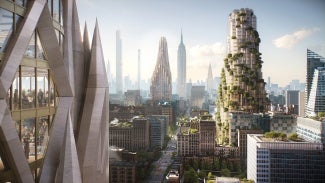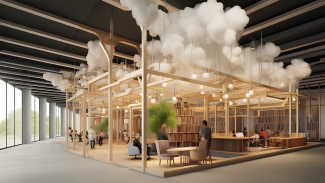
Who's afraid of artificial intelligence?
Not Matthias Hollwich, AIA, principal at HWKN, who is heading full bore into what he believes is a paradigm change.
In 2022, Matthias Hollwich, AIA, founding principal at the global architectural design firm HWKN, was having dinner in London with tech industry friends. One of them shared Dall-E, an Open AI variant that could create whimsical images from text. Dall-E (a mashup of the name of artist Salvador Dalí and Pixar’s robot character WALL-E) had made its debut the previous year. “We created a painting together,” Hollwich said from his New York office via Zoom. “It was the first time I’d confronted a creative tool I was unaware of.”
Then for fun, Hollwich put 20 images of himself into the photo enhancer Lensa. “It gave me 50 new images of myself. In one of them I liked the haircut,” he said with a laugh, “and took the image to my barber who cut my hair based on the AI invention.”
While the activity might seem trivial, Hollwich called it an “‘Aha! Moment.'"
“If I could redesign myself through AI and have it physically translated, this is architecture. This is how we basically do our process here at HWKN,” he said.
For Hollwich, playing, exploring, experimenting, and innovating are serious business and likely why in March, Fast Company honored HWKN as one of its Most Innovative Companies in architecture. Since his “aha” moment, Hollwich has been redefining how HWKN — and perhaps the architecture industry itself — can use AI to its advantage.
Test and create
Hollwich and his partners at HWKN explored various AI programs including Arkdesign (the first AI platform for schematics); Spacemaker (now owned by Autodesk, which creates and evaluates options early in the design process); and Midjourney (which produces stunning visuals). They learned a few things right away, particularly with Midjourney. They inserted prompts and played around in the system. What emerged “was super ugly,” Hollwich said, “but the kind of forms that were created were interesting. We knew we could train the model and come to a design direction that looked a little like something HWKN might do.”
Today’s AI is biased in that it pulls only from images that already exist online, and the prompting itself can lead to biased responses. For example, if you don’t ask AI to retrieve building ideas from all over the world, you may end up only with popular Western typologies. Hollwich and his team worked at refining and controlling their prompts and began to see that AI could do more than help create HWKN-style buildings. “We can actually reinvent architecture with it and find new sets of rules,” he said. “The prompt is the crucial element.”
HWKN then did something Hollwich calls “reverse engineering.” They rebuilt an image in Rhino 3D modeling software “and translated it into an architectural proposition. It became simpler and a little more architectural.” They tried different prompts and “let AI loose in Frankfurt [Germany], generating 5,000 different designs,” he said.
The sheer number of possibilities was great, but “when you can do everything, you do nothing,” Hollwich said. “You have to find a purpose.” He likens the dawning of AI to the beginnings of Modernism. “When industrialization came into architecture and we could mass fabricate buildings, that was a revolution,” he said. Many architects abandoned craft and Modernism became a standard. Hollwich believes AI is not just a trend but a new tool that can generate something entirely new just as Modernism did. “We’re at the moment of paradigm change. We believe you can use the tool to be much more contextual, and that’s where the value is in today’s economy.”
Refining a system
HWKN continued tinkering with ways to create new forms and context. Ask people about architecture in New York City, for example, and they may mention the Chrysler and Empire State buildings. HWKN used those built examples and many others as prompts in Midjourney, and the output were modern interpretations that a viewer would understand and connect with emotionally as Manhattan structures (which HWKN called “Neo York”).
HWKN explored further. They tried brands such as Patagonia and Gucci and tested how they might prompt AI to create emotionally resonant structures. Then they tried using people’s personalities to generate a building. They input information about film directors, sports figures, fashion icons, and AI translated. “Our thinking was, if we can use this amazing technology to build buildings, let’s stop building boring buildings,” Hollwich said.
As far as he knows, no building has been built solely on AI prompting. However, HWKN is coming close. In 2023, a client hoping to purchase a building in a desirable area in downtown Cologne, Germany, contacted Hollwich. The client hoped HWKN could come up with renovation ideas that the city would approve. If so, he would buy the site and move forward. “He needed a concept in five days to present to the city,” Hollwich said.
The site, near Cologne’s main train station and the Cologne Dom cathedral, holds a 1960s-era office building used by the postal service. The two architecturally iconic city landmarks became the inspiration for the AI. Using the cathedral first, the initial iteration was “spectacular, but almost made the client faint,” Hollwich said. It looks a bit like a jagged toothed fortress or perhaps something a giant might scrape his boots on. They switched gears and skewed toward the train station’s industrial feel. Ultimately, the client settled on a design with arches that reference the station. It took HWKN days to do what might have previously taken weeks to accomplish. The project is currently in design development.
HWKN’s process has evolved into two phases: exploration and articulation. The first phase involves brainstorming via focused dialogues with Chat GPT; scripting using lengthy prompts to delve into a project’s essential elements; world-building in Midjourney; and hallucinating, which offers thousands of alternatives that prioritize emotional resonance (since hallucinations, a well-documented AI glitch, are notorious for being untrustworthy) rather than conventional, rational limitations. In phase two, the process continues with selection for structures holding exceptional promise; refinement that blends dreamscapes with reality; reverse engineering for final designs with a focus on the practical; and crafting to marry logical reasoning with the project’s emotional core.
Hollwich said there remains a missing link, however, when it comes to “connecting the AI vision with the rational.” HWKN still shifts to BIM and 3D models after initial AI ideation, but Hollwich believes that connection will happen soon.

Set aside fears
As with the Cologne project, Hollwich has found that AI can help save time. Some design professionals see that as a problem. When time is money, who gets the savings? Competing on price is a downward spiral.
Hollwich sees it differently. Clients try to minimize the cost of architecture at the early phases “because that’s the time of their highest risk. We often work for very little money for the design,” he explained. When the design becomes a real building, architects are paid a larger fee. “I see this issue in the opposite way. With AI, architects finally can see less of a loss at the beginning and still get paid fairly. And hopefully it will help us in the in-between time to have a better financial standing because the early pay basis always leads to underpayment," he said. "We shouldn’t reduce fees but use AI to make us faster and more efficient so that we can save our resources and raise the glass ceiling.”
In addition, architects need to lean in on their value proposition, their very humanness — discovering purpose and context and doing so by creating prompts. HWKN’s scripted prompts run dozens of pages.
Where Hollwich does see a challenge from AI is with the architect’s traditional unique sales proposition, their own creativity. He again references the 1930s and Modernism. “There were architects who still wanted to do ornate projects, but the industry had moved to the next level, to ‘Modern white boxes,’” he said. “Architects at some point might have innovated within that new system and created very different types of buildings. I think that will happen with AI in the end because it’s going to result in different cities and buildings. The key here is that AI will also innovate the way we [physically] build buildings.”
AI’s newly created environments may bring us all back to the future. AI will train robots and humanoids (robots with human features) to do the intricate work that skilled craftspeople once did. (Hollwich pointed out that this already is happening in other industries such as ABB Robotics, Wasp 3D printing, and China’s Dongfeng Motors.) “Because labor is so expensive, and it now can be enhanced with humanoids and robots, we can go back to craftsmanship and potentially build more complex and more contextual buildings," he said. "These are the spaces people really like to experience. Not just a square box.”
While AI may prove better at doing many of the tasks architects do, Hollwich said, “we can also use it as a companion to help us increase our goals and explore — in the same way Modernism explored new typologies. Maybe not with the focus toward industrialization, but with the focus of individualization, contextualism, and personalization. We have to redefine what we’d like to achieve.”
Stacey Freed is a freelance writer based in New York state.
You can read more about AI from AIA here.
